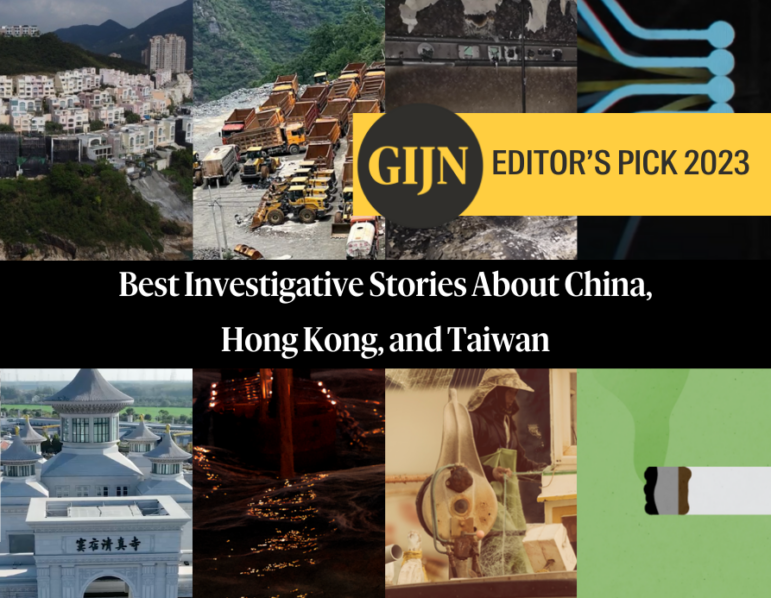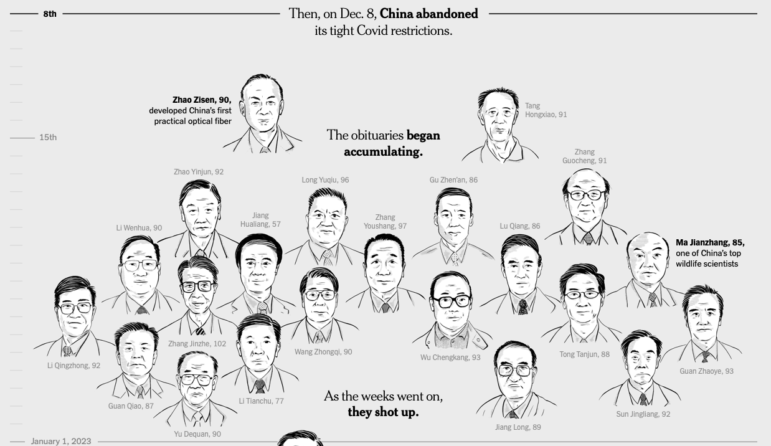

Image: GIJN
Lobster Smuggling, Hospital Fire, Tobacco Industry: 2023’s Best Investigative Stories About China, Hong Kong, and Taiwan
Read this article in
The year 2023 was another challenging one for investigative journalism in China. In this year’s World Press Freedom Index released by Reporters Without Borders, China ranked second to last among 180 countries, just ahead of North Korea. The level of information censorship and manipulation by the Chinese authorities has reached a highly sophisticated level. Working in investigative journalism under these conditions is exceedingly difficult, and made the selection for this year’s editor’s picks particularly tough. Of the eight stories selected, only two originated solely from mainland China.
Fortunately, this year there were more Chinese-language investigative reports published outside China, and English-language reports involving Chinese journalists. Given the deteriorating state of press freedom in China, future investigations may increasingly come in these forms. Therefore, in our selection this year we included four Chinese-language investigative reports from Taiwan, Hong Kong, and Singapore, as well as two English-language reports, from the BBC and the Financial Times. There are no doubt many excellent English-language investigative reports about China, but for this list, we included reporting led by — or with significant contribution from — journalists with a Chinese background. Below are our picks for 2023’s best investigations relating to China, Hong Kong, and Taiwan.
Investigation of the Cover-up of Miner Fatalities in Shanxi
On September 1, 2022, a landslide accident at a large iron mine in Shanxi province in northern China resulted in three deaths. Following this, it and other local mines were shut down for rectification. In 2023, China Newsweek (not connected to US Newsweek) received a tip-off alleging that over 30 deaths at the Shanxi-based mining company caused by safety accidents had been concealed.
China Newsweek’s reporter traveled across Shanxi, Shaanxi, and Chongqing, visiting a total of 20 villages to investigate and verify the alleged cover-up. Their findings revealed multiple unreported mining accidents from 2007 to 2022, involving at least 17 miners. The investigation included interviews with several family members of the deceased miners, whose testimonies confirmed the secrecy about the tragedy. It also cast a glimpse into the local iron-mining industry: The area’s once largest contractor — who had been sentenced for leading organized crime — and his foremen were responsible for contracting the majority of the mining work.
Shortly after this investigation was published, China’s mine safety administration took action against the mine for the cover-up and launched a nationwide campaign to address the issue of false reporting in mining accidents. As a result, criminal charges were recommended against nine individuals from the mining company.
How China Is Tearing Down Islam
Beijing’s Doudian Mosque, renowned for its impressive domes and intricate minarets, was one of northern China’s most magnificent. However, this year its minarets were dismantled, its domes replaced with pagoda-style cones, and its Arab-style arches squared off. This transformation of Doudian Mosque reflects a broader trend across China, where, over the past five years, hundreds of mosques have undergone similar modifications.
A visual investigation by the Financial Times using satellite images shows a widespread policy of removing Arab-style features from mosques, often replacing them with traditional Chinese designs. In some instances, mosques have been completely demolished. Satellite analysis in the western region of Ningxia reveals that over 90% of mosques with Islamic architecture have been altered. In Gansu, a northwestern province, the figure exceeds 80%.
To monitor the Chinese government’s Sinicization policy, the reporting team compiled a dataset of 4,450 mosque locations throughout China, created by merging search results from Baidu Maps, Google Maps, and OpenStreetMap, along with data on mosques in Xinjiang from the Australian Strategic Policy Institute. They also used Google Earth satellite imagery to identify mosques and track architectural changes over time. Out of 2,312 mosques identified with Islamic architecture, 1,714 (74.3%) had their Arabic-style features removed or altered between 2018 and 2023.
China’s Smoking Addiction
Over the past two decades, the global rate of tobacco use has decreased by 11%. In China, however, this decline was a mere 1%. Despite constituting one-fifth of the world’s population, China currently consumes nearly half of the world’s cigarettes — over 2.4 trillion annually — a figure that surpasses the combined total of the next 67 countries. The prevalence of smoking in China leads to severe public health consequences, with an expected surge in smoking-related deaths that will impact 700 million non-smokers.
Initium Media, in collaboration with The Examination (U.S.), Der Spiegel (Germany) and Paper Trail Media (Germany/Austria/
The China National Tobacco Corporation, a colossal state-owned enterprise, oversees both the country’s regulation and the production and sale of tobacco. Initium Media’s investigation found that not only did this corporation play a pivotal role in negotiating and translating the Chinese version of the World Health Organization’s Framework Convention on Tobacco Control (WHO FCTC), but it also strategically obstructed, delayed, and influenced the implementation of the FCTC in China. By leveraging its economic power and governmental status, it has weakened China’s public health policies and influenced a range of top-level Chinese leaders.
Beijing Changfeng Hospital Fire
On April 18, 2023, a major fire broke out at Beijing’s Changfeng Hospital, resulting in 29 deaths and 42 injuries, and a direct economic loss of ¥38.3 million (US$5.4 million). The Chinese authorities determined that the fire was caused by the hospital’s illegal renovation project and the chaotic management of construction safety and daily operations, combined with an ineffective emergency response. Following the fire, 12 individuals, including the hospital’s management and those responsible at the construction company, were criminally detained.
Caixin’s rapid investigation of the tragedy detailed the situation at the fire scene, investigated the causes, and systematically reviewed the longstanding issues at the hospital. This hospital had heavily invested in online marketing, spending a significant amount on search engine advertisements. However, it had been suffering from continuous losses in recent years, with an increasing debt-to-asset ratio. Moreover, the hospital had illegally altered its original building layout, leading to serious violations in fire separation and safety evacuation standards. Many of its fire safety facilities had never been tested.
Given that the fire occurred in Beijing, China’s capital, and resulted in numerous casualties, reporting on it was highly sensitive. The Caixin reporting team, through extensive interviews and investigations, provided a crucial analysis of the fire’s cause and the involved company’s business status, making their report one of the most important investigations into the incident.
Selling Online Sexual Violence
The BBC uncovered a disturbing online marketplace where thousands of videos featuring men sexually assaulting women in public spaces across East Asia are being sold. Customers can even commission custom-made assaults. At the center of this operation is a mysterious figure known only as “Uncle Qi,” revered as a mastermind by an underground network of sexual predators. The investigation takes a dramatic turn in Japan, delving into the notorious phenomenon of Chikan — a Japanese term for public sexual assault.
In this video investigation, BBC reporters used open source research and undercover techniques to reveal the true identity of Uncle Qi, which culminated in a dramatic confrontation between the BBC journalists and Uncle Qi, who subsequently fled Japan. This investigative piece gained significant attention in mainland China, where it was widely shared and discussed. Notably, various official media outlets and even police department Weibo accounts disseminated the BBC’s investigation, enhancing the impact of the investigation and raising awareness about this crucial issue.
Uncovering the Australian Lobster Smuggling Route to China
Since 2020, China has imposed trade sanctions on Australia, including a ban on lobsters from that country. As a result, these lobsters have found new markets in Hong Kong and Taiwan. In 2022 alone, Taiwanese imports of Australian lobsters surged by over 800 tons. An investigation by The Reporter found that smuggling Australian lobsters has become a burgeoning industry in Taiwan, as many of these lobsters are instead smuggled to Kinmen and Matsu islands close to mainland China, and from there, Chinese fishing vessels are illicitly transported to Chinese cities.
According to the report, the profit from smuggling Australian lobsters is astonishing: a 20-kilogram box of lobsters, costing 24,000 New Taiwan dollars (US$766) for import, can fetch up to 66,000 NTD (US$2,106) when smuggled into China. Through a series of three investigative articles, The Reporter unveiled this smuggling network, and examined the historical and geographical factors contributing to the growth of the smuggling industry in Kinmen and Matsu.
Storm Beneath the Strait
Since 2005, Chinese sand dredging boats have been illegally extracting sand from the seas near Taiwan’s outlying islands. According to estimates from biodiversity researchers, at the peak of these activities, Taiwan experienced the theft of over one million tons of marine sand annually. The sight of numerous Chinese dredging boats became a daily occurrence for island residents.
The Reporter’s investigation found that these Chinese sand dredgers, initially concentrated around Kinmen, have shifted their operations to the seas near Matsu and Penghu. This has not only severely damaged the marine ecosystem, but also affected the fishing activities in Penghu, leading to a halving of the annual catch of important fish species such as barred knifejaw and a drop in the annual catch of grouper — from over 300 tons to less than 80 tons. In the past six years, sand dredging has also damaged the undersea cables between Taiwan and Matsu nearly 30 times.
Through various media, the investigation portrayed the Chinese sand dredging industry supply chain and found that the activity largely fluctuates with Beijing’s policies and follows a specific geopolitical pattern. Although China intensified its crackdown on dredging in 2020-2021, with the easing of the pandemic and economic recovery the demand for marine sand has risen again, and whether China will continue to enforce its crackdown remains to be seen.
Illegal Construction on Red Hill Peninsula
In early September 2023, Hong Kong experienced its most severe rainstorm in 140 years. The torrential downpour triggered numerous landslides, exposing potential illegal construction and encroachments on government land in the low-density villa areas of Red Hill Peninsula. The newly established nonprofit investigative outlet, The Collective, conducted on-site inspections and cross-checked documents from the building department and the town planning board. They discovered multiple instances of unauthorized construction of villas, with one example having encroached on government land for as long as 23 years.
When did these illegal constructions begin? How had the Hong Kong government enforced regulations in the past? The Collective’s review of more than 50 coastal independent house records revealed that eight of them had been ordered by the building department to demolish unauthorized structures. Three of these orders, issued between a year and a half to nearly three years ago, had still not been carried out.
Shortly after the release of the investigative report, the Hong Kong government announced that of the 85 coastal independent houses on Red Hill Peninsula, 70 were involved in unauthorized constructions, 40 in encroaching on government land, and over 30 in both. However, considering the government’s past enforcement track record, the outcome of rectifying these issues remains concerning.
Joey Qi is the editor of GIJN in Chinese. He has over 10 years experience in journalism, including three years in media management. He is one of the founding members of The Initium Media, where he designed the daily news section and built the team.

















